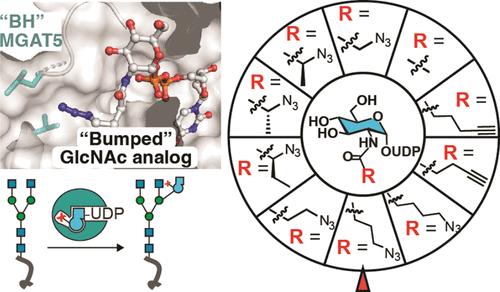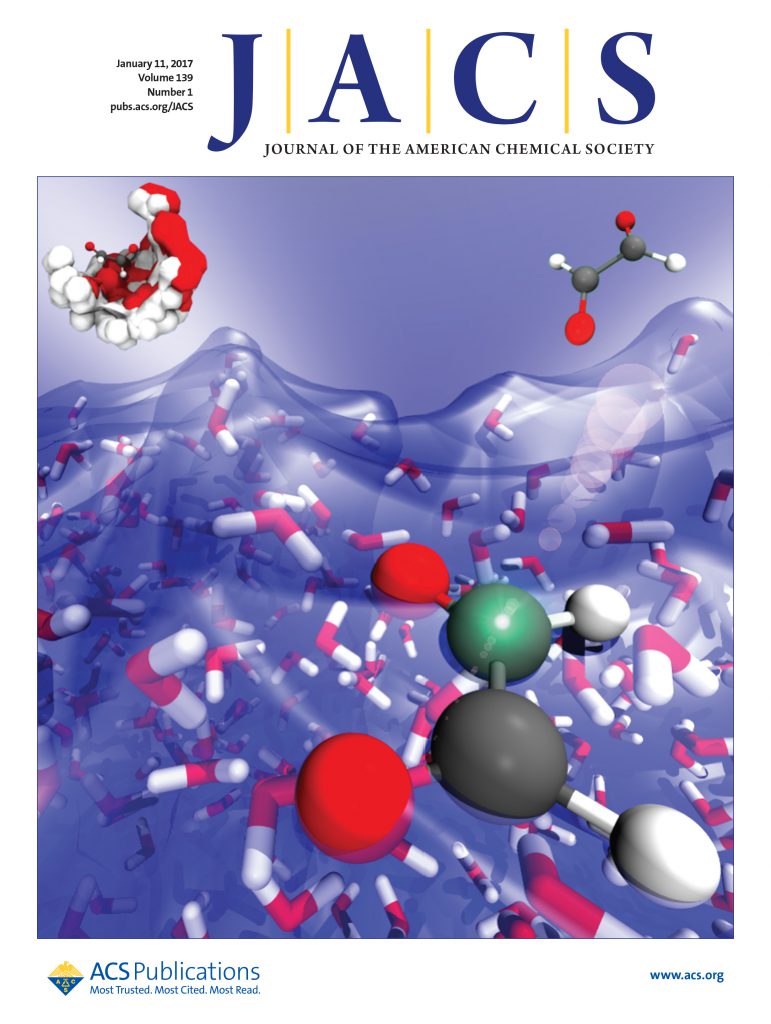A Bioorthogonal Precision Tool for Human N-Acetylglucosaminyltransferase V
IF 14.4
1区 化学
Q1 CHEMISTRY, MULTIDISCIPLINARY
引用次数: 0
Abstract
Correct elaboration of N-linked glycans in the secretory pathway of human cells is essential in physiology. Early N-glycan biosynthesis follows an assembly line principle before undergoing crucial elaboration points that feature the sequential incorporation of the sugar N-acetylglucosamine (GlcNAc). The activity of GlcNAc transferase V (MGAT5) primes the biosynthesis of an N-glycan antenna that is heavily upregulated in cancer. Still, the functional relevance and substrate choice of MGAT5 are ill-defined. Here, we employ protein engineering to develop a bioorthogonal substrate analog for the activity of MGAT5. Chemoenzymatic synthesis is used to produce a collection of nucleotide-sugar analogs with bulky, bioorthogonal acylamide side chains. We find that WT-MGAT5 displays considerable activity toward such substrate analogues. Protein engineering yields an MGAT5 variant that loses activity against the native nucleotide sugar and increases activity toward a 4-azidobutyramide-containing substrate analogue. By such restriction of substrate specificity, we show that the orthogonal enzyme–substrate pair is suitable to bioorthogonally tag glycoproteins. Through X-ray crystallography and molecular dynamics simulations, we establish the structural basis of MGAT5 engineering, informing the design rules for bioorthogonal precision chemical tools.

人类 N-乙酰葡糖胺基转移酶 V 的生物正交精密工具
人类细胞分泌途径中 N-连接聚糖的正确合成在生理学中至关重要。早期的 N-聚糖生物合成遵循流水线原则,然后再经历关键的加工点,这些加工点的特点是依次加入糖 N-乙酰葡糖胺(GlcNAc)。GlcNAc转移酶V(MGAT5)的活性为N-聚糖天线的生物合成奠定了基础,而N-聚糖天线在癌症中严重上调。然而,MGAT5 的功能相关性和底物选择还不明确。在这里,我们利用蛋白质工程学来开发一种生物正交底物类似物,以提高 MGAT5 的活性。我们利用化学酶法合成技术生产了一系列带有笨重、生物正交酰酰胺侧链的核苷酸-糖类似物。我们发现 WT-MGAT5 对此类底物类似物具有相当高的活性。蛋白质工程产生了一种 MGAT5 变体,它失去了对原生核苷酸糖的活性,而增加了对含有 4-叠氮丁酰胺的底物类似物的活性。通过这种对底物特异性的限制,我们证明了正交酶-底物对适用于生物正交标记糖蛋白。通过 X 射线晶体学和分子动力学模拟,我们建立了 MGAT5 工程的结构基础,为生物正交精密化学工具的设计规则提供了参考。
本文章由计算机程序翻译,如有差异,请以英文原文为准。
求助全文
约1分钟内获得全文
求助全文
来源期刊
CiteScore
24.40
自引率
6.00%
发文量
2398
审稿时长
1.6 months
期刊介绍:
The flagship journal of the American Chemical Society, known as the Journal of the American Chemical Society (JACS), has been a prestigious publication since its establishment in 1879. It holds a preeminent position in the field of chemistry and related interdisciplinary sciences. JACS is committed to disseminating cutting-edge research papers, covering a wide range of topics, and encompasses approximately 19,000 pages of Articles, Communications, and Perspectives annually. With a weekly publication frequency, JACS plays a vital role in advancing the field of chemistry by providing essential research.
文献相关原料
| 公司名称 | 产品信息 | 采购帮参考价格 |
|---|

 求助内容:
求助内容: 应助结果提醒方式:
应助结果提醒方式:


